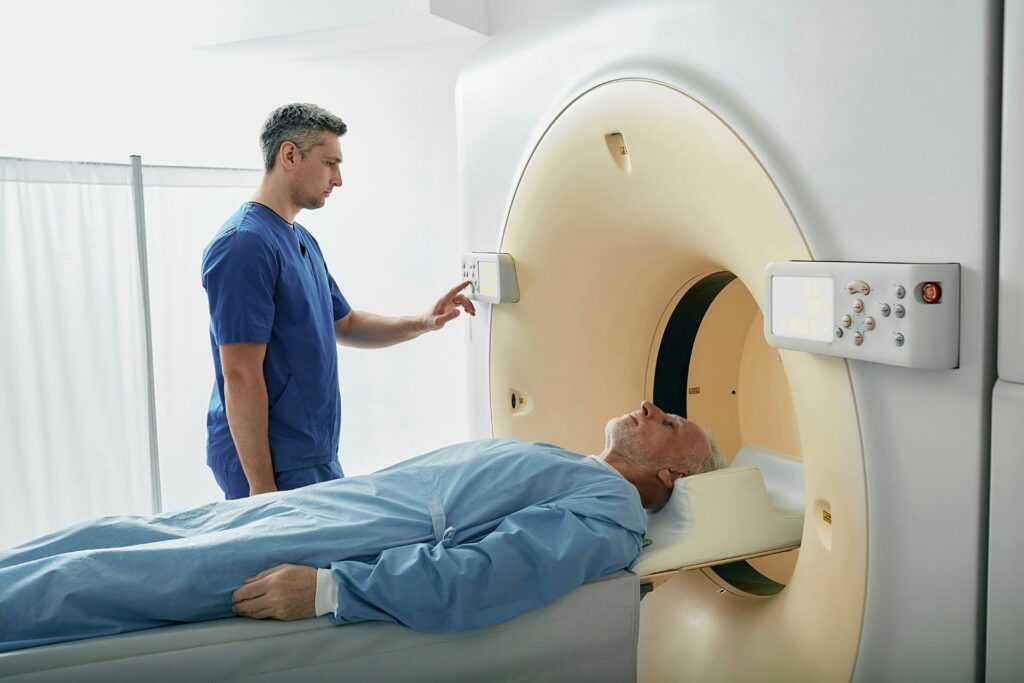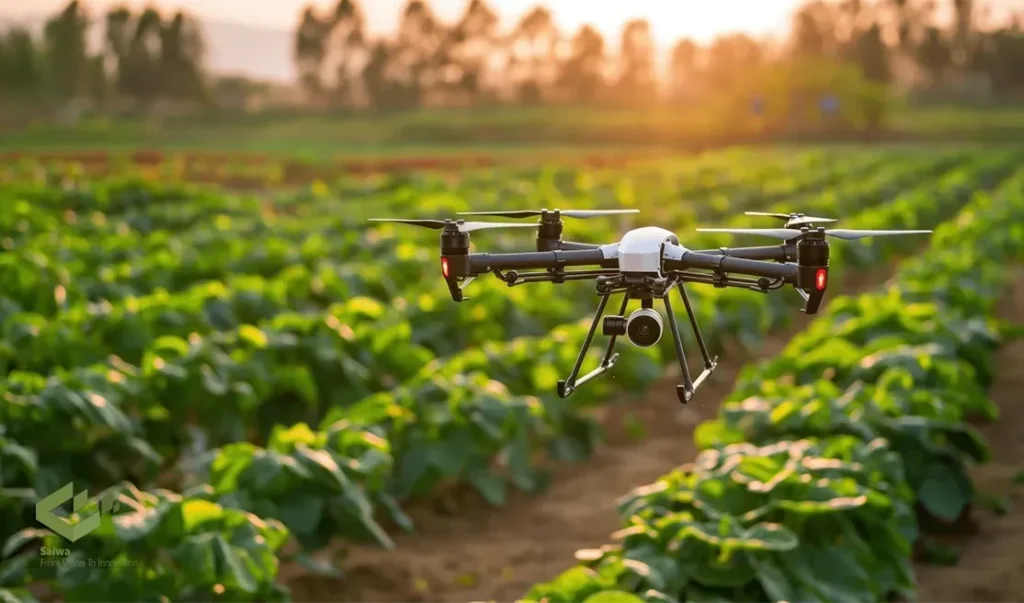Synopsis: Explore the top 7 sectors where AI plays an important role in the next 5 years, and fields in which AI is impacting and its applications. The rapid AI adoption in India will reshape industries, boost productivity, and unlock new growth opportunities.
The Indian market for artificial intelligence is going through a tremendous and rapid growth, which is expected to increase from 13.05 billion dollars in 2025 to 130.63 billion dollars by 2032, with an astonishing 39% compound annual growth rate (CAGR).
1. Healthcare

India’s healthcare sector will grow from $12.87 million in 2024 to $44.87 million by 2030, representing a 23.14% CAGR. AI applications in the healthcare sector are:
- Imaging analysis(CT scans, MRI’s)
- Pathology
- Predictive analytics
- Patient management system, and
- Drug discovery
The government is pushing digitization and AI integration with the implementation of schemes such as the Ayushman Bharat Digital Mission and National Digital Health Mission along with the healthcare budget of India 2024 which will amount to ₹909.59 billion). Bangalore, Chennai, and Hyderabad are at the forefront of the market’s growth in cities due to their excellent IT infrastructure and world-class medical services. By the year 2025, the contribution of AI to the Indian GDP is expected to be $25-30 billion as a result of better patient care, more efficient processes, and R&D.
2. Banking, Financial Services & Insurance (BFSI)

The BFSI (Banking, Financial Services, and Insurance) sector accounts for the biggest portion of the AI market in India and also shows the highest rate of adoption. A study by PwC shows that 90% of Indian banks have raised their AI budgets
- AI-driven fraud detection systems are now deployed by 65%
- AI application chatbots 80% deployment
- Credit assessment
- Algorithmic trading
- Compliance monitoring
- Wealth management
AI bots are providing a response time cut down of 80% and cost-saving of 35% in the customer service department. The IT spending of the Indian banking sector is estimated to rise to $15 billion in 2025, which will be mainly due to the use of proprietary cloud platforms and agentic AI applications.
3. Manufacturing

The integration of AI and machine learning is causing a major change in India’s manufacturing industry and digital technologies are expected to take up 40% of the manufacturing total cost by 2025, a steep climb from 20% in 2021. Uses in the fields of:
- Predictive maintenance
- Quality control through AI driven machine vision
- Robotics automation
- Supply chain optimization
- Defect detection and
- Production workflow optimization
4. Retail & E-commerce

Retail and e-commerce driven AI is going to experience considerable growth from 2025 to 2030, and 71% of retail companies are predicted to use generative AI by 2024. The industry is expected to obtain productivity improvements of 35-37% in 2030 due to AI-enabled solutions. AI applications includes:
- Personalized product recommendation
- Dynamic pricing based on real-time demand
- Customer analytics
- AI powered chatbots, and
- Visual search capabilities
Performing complex tasks like accurately assembling tiny parts, while the chemical and pharmaceutical sectors are using AI. The use of AI by Amazon’s Rufus and Flipkart’s Flippi for their recommendation engines helps in making better product suggestions and providing real-time assistance to the customers. Additionally, AI-based demand forecasting, inventory control, and supply chain optimization have resulted in 30% reduction of operational costs as well as better customer satisfaction.
Also read: Top 10 Rapidly Expanding Sectors in India to Watch in 2025
5. Agriculture

In the year 2030, we will see a major shift in the ways of farming and the whole agricultural industry adopting AI to its fullest potential. AI applications depict the following areas of the main benefits which would be offered by the AI such as:
- Drones monitoring crops
- Analyzing crops and soil
- Detection of diseases (reaching 95% accuracy for ailments like apple scabs and wheat rust) Forecasting of yields
- Intelligent spraying
- Automatic irrigation, and
- Livestock health monitoring
The utilization of AI tools has brought about a twofold increase in the earnings of smallholder farmers in India as a result of better crops and optimal use of resources. The smart farming investments in India are expected to reach $2, thus allowing further developments in satellite crop monitoring, hyperlocal weather advice, pest prediction systems, and automated farm machinery.
6. IT Services & Software Development

India’s IT sector contributes 7.5% of the GDP, and is expected to grow above $400 billion by 2030 as AI brings the change in technology delivery. The usage of AI in development tools like GitHub Copilot and Tabnine is completely changing the way software is made as they are able to write code, give suggestions about optimizations, and even debug code simultaneously.
TCS, Infosys, and Wipro, which are the major Indian IT firms, are integrating AI into their processes, and TCS is going to equip one hundred thousand workers with AI skills. It is the healthcare sector that will be the largest contributor at $372 billion by 2025 . The growth has been fast-tracked by the government’s backing through the IndiaAI Mission (₹10,372 crore), National AI Strategy, and purchasing over 10,000 GPUs for research and development.
7. Education (EdTech)

AI is reshaping India’s education system through hyper personalized learning platforms that adapt to individual student needs, pace, and learning styles. The global AI in education market is projected to grow from $5.88 billion in 2024 to $32.27 billion by 2030 at a 31.2% CAGR. AI applications include adaptive learning platforms (used by BYJU’s, UpGrad, Personalized content delivery)
- AI tutors and chatbots providing 24/7 support
- Automated assessment and feedback, and
- Multilingual education tools breaking barriers for rural learners.
In the capital city of India, approximately one-half of the students pursuing higher education have been reported to be using AI-based applications quite often, the daily usage being 23% and the monthly usage being 21% for different purposes including getting assistance in the writing process, doing the research, and comprehending difficult subjects.
The Indian Union Budget of the year 2025-26 revealed that a Center of Excellence in Artificial Intelligence for the purpose of education would be set up with a whopping ₹500 crore investment plus 50,000 Atal Tinkering Labs in government schools by the year 2031. Indian classrooms will be transformed into hybrid, technologically enabled spaces with AI-powered interactive boards, IoT devices, and platforms like DIKSHA providing free AI-powered multilingual content by the year 2030.
Conclusion
India is ready to be a world AI leader by the year 2030, and these 7 sectors healthcare, BFSI, agriculture, manufacturing, retail & e-commerce, IT services, and education are going to be the main contributors to this change. In addition, these sectors will also boost the economy, enhance productivity, and elevate the living standard of millions of people.
Written by Yatheendra N


